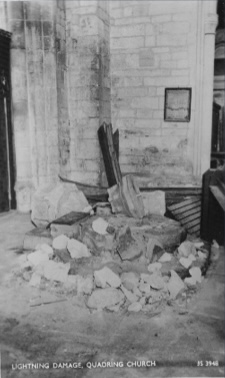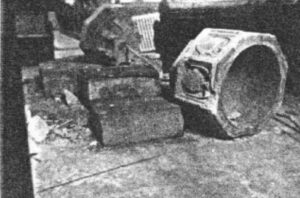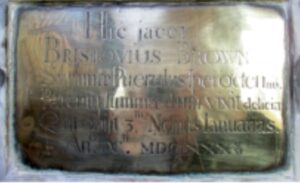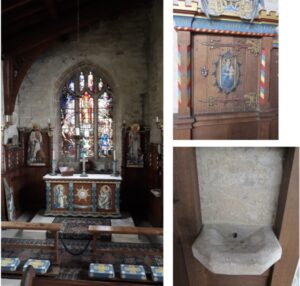
This church stands next to Quadring school in isolation from the village, and is dedicated to Saint Margaret of Antioch. A church has stood in this spot for 700 years.
In ancient Lincoln Diocesan records, there is an account of a vicar being inducted to Quadring in 1250. In the Domesday Book of 1086 (which records properties and population of England), a large section of Quadring parish belonged to the Bishop of Lincoln. He was obliged to provide for the religious needs of the people, so a church was built. Others involved in this were the Percy family. They bequeathed the church to the Abbess of Stainfield Priory (which they owned) close to Lincoln. In the reign of Henry VIII, Stainfield Priory was damaged and Quadring Church was likely to have been damaged then as well.
Edward VI allowed the Bishop of Lincoln to regain ownership of the church, and he was once more in charge of appointing priests.
The Ancient Church Registers show us how good and bad times occurred. In Elizabeth I’s time, a young vicar came to take charge of the church, but the damp fenland must have been a challenge to his health. In two years he lost his wife and two children, then died himself.
Arial view of the building:
 On entering the church, the first noticeable thing is its light and spacious interior. To the left of the door, there is an ancient “hood” or “hude” — these were particularly used in the Fens during funerals to shelter the vicar at the graveside on wet or misty days.
On entering the church, the first noticeable thing is its light and spacious interior. To the left of the door, there is an ancient “hood” or “hude” — these were particularly used in the Fens during funerals to shelter the vicar at the graveside on wet or misty days.

To the right, in the first window, is a panel of glass with “D Gemy of Ely 1793” scratched into it.

To the right, in the south Transept, there is a chapel dedicated to St. John. It was used for sacramental worship. The Piscina for vessels is still there.
Above the chapel is a modern, stained glass resurrection window, designed by Brian Thomas and dedicated to Mary Randall (a village resident). To see the full effect of the window, you must see the sun shining on it.


Going back to the door and carrying on into the chancel, there is an ancient chest on the left, which was used to store Parish Registers. It had three locks to be opened by the vicar and two churchwardens (it could never be opened by one person alone.) In 1836, the chest and other items were stolen. The chest was found later with a broken lid in a nearby ditch. A reward of five guineas was offered for its return.
At the bell tower’s entrance, there is the font. It has an old Latin inscription at its base mentioning the Percy family: “Pray for the soul of Robert Percy who caused this font to be made.” The font has signs of new stonework as it was damaged when lightning struck the church tower in 1939 and bits of rubble fell on the font.




The bell tower has six bells.

Above the font are crevices in the wall which indicate that a singing gallery once existed here, which would have housed the choir together with the instruments (in the time before the organ was installed).
Turn to go down the chancel and look at the roof. On one of the beams there is evidence of newer wood, along with the date 1868 and two pairs of initials, I.P. and N.C. These are thought to be the initials of the churchwardens at the time of its repair.

On the chancel pillars there are faces and coats of arms (possibly of the Derby family). The Derby family gave the church eight windows for the nave in 1400. One pillar possibly features a Green Man.

Once there was a Roodstair and loft arching the chancel’s west end, but all that remains of it now is the turret with a door leading to a stone staircase.

The organ on the right was gifted by the Robinson family.

Next to the pulpit is a brass wall plaque with a Latin inscription that translates into:
HERE LIES BRISTOVIUS BROWN A PERFECT CHILD THE EIGHT-FOLD HOPE OF NOBLE PARENTS, WHILE HE LIVED A JOY. WHO DEPARTED IN THE THIRD YEAR OF HIS BIRTH, JANUARY 9TH YEAR OF OUR LORD 1685/6.

Electricity was installed in 1957 and there is a plaque on the right wall of the chancery marking this.

Going into the nave, the east window is dedicated to the Reverend Ashwin (a former vicar of Quadring) and his family.

Near the main altar on the left, there is a floor tablet with a barely legible inscription to Richard Pereson, vicar in 1472.
The lower right panel of the east window depicts St Hugh of Lincoln holding a model of Lincoln cathedral.

Returning from the nave and turning right, you find the Lady Chapel, with an Aumbry (upper right) and ancient Piscina (lower right) for washing vessels. The chapel is dedicated to the Virgin Mary.

Above the altar are brightly coloured stained glass windows which show Quadring Church, Lincoln Cathedral, and Stonehaven (home of the Robinson’s family who gave the window, and the three windows on the right depicting Christ’s life, to the church).


Returning to the church’s rear, you pass a memorial plaque to the Machin brothers, who fell on the same day in World War I on November 28th 1917.

Further along the north aisle is the ancient bier which is no longer used to carry coffins at funerals.

There is proof that the chancel and sanctuary once stretched further eastwards. The doorway (which is blocked with stone from the outside on the south side) was a priest’s door and would have led to a part of the chancel beyond the sanctuary. Now, the sanctuary has been moved forward to include the area where this doorway once was.

There is a little woodpecker carved into the north door just before the vestry.

On the outer wall to the right of the south door, the hours of the day are etched into the stone like the dial of a clock. Originally, a long, straight piece of metal was affixed to the dial’s centre, to throw a shadow to show the time of day. This “scratch-dial” would have been put there before clocks were introduced to England and when people relied on the sun to tell the time.

